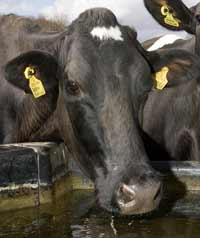Dairy Event 2009: Improving somatic cell counts

Farmers can make targeted and informed improvements to somatic cell counts by using Clover cell check, said James Allcock of Lambert Leonard and May at this week’s Dairy Event and Livestock Show. Clover cell check, sponsored by Cobactan, Intervet Schering Plough, allows dairy farmers to get more worth from their herd management systems, he said. “It is essential somatic cell counts are continually monitored to allow earlier treatment before cows are ‘broken’. “The problem is, farmers get so much information it is often difficult to pick out specific information and trends.” The program takes data the farmer receives through milk recording and automatically uses information on somatic cell counts to create an individual monthly report. The report is emailed to the vet so further in-depth interpretation can be carried out. And the report highlights specific cows for treatment. “Clover also shows trends in the herd and compares herd performance with other farms in the area. “The program is also highly motivational, providing a league table of farm results so farmers can see how they progress each month.” A simple traffic light system highlights areas of good and bad performance. “The system highlights specific risk areas in your system. For example, you may be identifying problems in heifers or at the first recording after calving, suggesting infection is occurring during the dry period.” “In one case a farm was experiencing high cell counts in late lactation. After doing a dynamic parlour check we identified liner slip as the primary cause.” After these changes the number of infected cows/month dropped from 10% of the herd to 3%. “When a cow is showing high cell counts before and after drying off, you should ask whether you should serve her again,” he said. “Of cows infected at drying off, you should be aiming to get 80% of them with low cell counts at your first recording. If you are not seeing these cure rates, ask why?”
